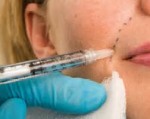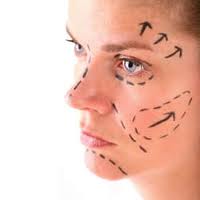 More and more women (and men) are seeking treatments to fill out those crow's feet, frown lines and wrinkles as well as puffing up lips. In response to the growing demand, more options are now available and people are reporting satisfactory results. Are they safe? What works best? How is it different than botox? The FDA is responsible for monitoring these products and has developed a helpful guide, Filling in Wrinkles Safely that provides important consumer information.
More and more women (and men) are seeking treatments to fill out those crow's feet, frown lines and wrinkles as well as puffing up lips. In response to the growing demand, more options are now available and people are reporting satisfactory results. Are they safe? What works best? How is it different than botox? The FDA is responsible for monitoring these products and has developed a helpful guide, Filling in Wrinkles Safely that provides important consumer information.
 Oral medication for treating a type of incontinence in women is roughly as effective as Botox injections to the bladder, reported researchers who conducted a National Institutes of Health clinical trials network study, with each form of treatment having benefits and limitations.
Oral medication for treating a type of incontinence in women is roughly as effective as Botox injections to the bladder, reported researchers who conducted a National Institutes of Health clinical trials network study, with each form of treatment having benefits and limitations.
After six months, women in both treatment groups said that the average number of daily episodes had declined from about five per day to about 1-2 per day.
In the study, the researchers compared the effectiveness of Botox injections to oral anticholinergic medications for treating urge urinary incontinence in women in nearly 250 women, average age 58. Anticholinergic medications reduce bladder contractions by targeting the bladder muscle through the nervous system. Many women who take anticholinergic medications relate having unpleasant side effects, including constipation, dry mouth and dry eyes.
The proportion of women receiving Botox whose urinary leakage completely went away six months after starting treatment (27 percent) was twice that of the group taking oral medication (13 percent). Women in the Botox group were more likely to experience incomplete bladder emptying or bladder infections, while the women taking the medication were a little more likely to report that they had dry mouth — a common side effect of the medication.
The study focused on treatment for urge urinary incontinence — the unpredictable release of urine shortly after feeling the urge to urinate. Information on urge incontinence as well as other kinds of incontinence is available from the National Institute of Diabetes and Digestive and Kidney Diseases
Women are twice as likely as men to experience urinary incontinence, and older women are more likely to experience it than are younger women. An estimated 15.7 percent of U.S. women experience urinary incontinence. Pregnancy and childbirth, menopause, and the structure of the female urinary tract account for this difference.
The findings appear online in the New England Journal of Medicine.
Urge incontinence results from unpredictable activity of the bladder muscles, the cause of which is often unknown. Botox injections work by relaxing the overactive muscles. In August 2011, the U.S. Food and Drug Administration approved Botox, or onabotulinumtoxinA, for the treatment of urge urinary incontinence when the cause of the overactive bladder is known, and due to spinal cord injury, multiple sclerosis or other nervous system disorders.
OnabotulinumtoxinA is not FDA-approved to treat an overactive bladder without a neurologic cause, even when other therapies have been found to be ineffective.
About the National Institutes of Health (NIH): NIH, the nation's medical research agency, includes 27 Institutes and Centers and is a component of the U.S. Department of Health and Human Services. NIH is the primary federal agency conducting and supporting basic, clinical, and translational medical research, and is investigating the causes, treatments, and cures for both common and rare diseases. For more information about NIH and its programs, visit www.nih.gov.
 A migraine is the most common type of headache that propels patients to seek care from their doctors. Roughly 30 million Americans suffer from migraine headaches, with women affected almost three times more often than men, according to statistics from the National Headache Foundation in Chicago. Today's blog incorporates an article by Jennifer Wider, MD of the Society for Women's Health Research.
A migraine is the most common type of headache that propels patients to seek care from their doctors. Roughly 30 million Americans suffer from migraine headaches, with women affected almost three times more often than men, according to statistics from the National Headache Foundation in Chicago. Today's blog incorporates an article by Jennifer Wider, MD of the Society for Women's Health Research.
"Hormonal changes are a big contributor to the higher female incidence,” said Michael A. Moskowitz, MD, Professor of Neurology at Harvard Medical School at the Massachusetts General Hospital in Boston. “There are lines of evidence that support this from lab to clinical evidence and a decrease (although not abolished) incidence in post-menopausal females.”
Migraine headaches can vary from person to person, but they typically last from four hours up to 72 hours. Some people get them several times per month, while others experience them much less frequently. Many migraine sufferers report throbbing or pulsating pain on one side of the head, blurred vision, sensitivity to light and sound, nausea, and vomiting. Roughly one in five migraine sufferers experience an aura, or visual or sensory disturbance, before the onset of the headache. Examples of an aura include: flashes of light, loss of vision, zig-zag lines, pins and needles in an arm or leg, and speech and language problems.
Several risk factors have been identified that increase a person’s chance of having migraines:
- Family history: A significant majority of migraine sufferers have a family history of migraine attacks. For a person who has one or more first-degree relatives with migraine headaches, the likelihood rises substantially.
- Age: Migraines typically affect people between the ages of 15-55. Most people have had their first attack by 40 years old.
- Gender: Women are more likely to suffer from migraines than men.
- Certain medical conditions: depression, anxiety, stroke, epilepsy, and high blood pressure are all associated with migraine headaches.
- Hormonal changes: Women who suffer from migraines often find that the headaches have a pattern of recurrence just before or shortly after the onset of menstruation. The headaches may also change during pregnancy and/or menopause.
Migraines are vascular headaches but the exact cause is not fully understood. Some researchers believe that migraines occur when there are abnormal changes in the brain. When these changes occur, inflammation causes blood vessels to swell and press on nerves, which can result in pain.
Researchers have learned that certain triggers can set off migraine attacks. These triggers vary from person to person and can include: sleep disturbances, stress, weather changes, low blood sugar, dehydration, bright lights and loud noises, hormonal changes, foods that contain aspartame, foods that contain tyramine (fava beans, aged cheeses, soy products, etc.), caffeine, and alcohol.
Unfortunately, migraines have no known cure, but they can be managed effectively with the help of a health care provider. A variety of drugs can be used for pain relief and for prevention. Lifestyle changes are often recommended to identify and eliminate possible triggers that can set off an attack.
“Until recently there have been no treatments available to treat people who suffer from chronic migraines,” said Moskowitz. However, she does mention that BOTOX has been helpful in some cases as was discussed in one of our earlier blogs. Chronic migraine sufferers have also found relief in certain vitamins and other homeopathic remedies. But patients should check with their doctors for proper treatment protocols.
Jennifer Wider, MD
SWHR, Contributing Writer
 Is it more effective to freeze your love handles, killing the fat cells between two super-cooled plates in a procedure known as cryolipolysis, or vacuum them away with liposuction? And which lasts longer, a surgical facelift or facial skin tightening via a laser?
Is it more effective to freeze your love handles, killing the fat cells between two super-cooled plates in a procedure known as cryolipolysis, or vacuum them away with liposuction? And which lasts longer, a surgical facelift or facial skin tightening via a laser?
Consumers often are in the dark about the most effective and safest cosmetic dermatology procedures to improve skin texture and color and remove subcutaneous fat, a surging $10 billion industry in the United States. One reason is a dearth of comparable research trials, reports a new Northwestern Medicine study. The study, published in the January issue of the journal Dermatologic Clinics, reviews existing research and identifies which procedures have been proven safe and effective and which ones have less evidence behind them.
“Many treatments gaining popularity are novel techniques that use complex devices, such as lasers and ultrasound, but there is sparse research evaluating their long-term effects,” said lead author Murad Alam, MD, chief of cutaneous and aesthetic surgery at Northwestern University Feinberg School of Medicine. “We need more prospective studies comparing different treatments for the same problem head-to-head, so doctors and consumers know what’s best and safest.”
Best-Known, Proven Procedures
Alam said the cosmetic dermatology surgical procedures that are well-known to be safe and effective when done by a trained, board-certified physician include: injected neurotoxins to smooth wrinkles; liposuction to remove fat; and lasers to treat broken blood vessels, port wine stains and rosacea and for removing brown spots and hair.
Newer, Lesser-Known Procedures
Other procedures that may be effective but have less evidence behind them include devices that use infrared light or ultrasound to purportedly shrink and tighten the skin, low-level laser light for fat removal, and fat “melting” by super cooling the fat cells, Alam noted. These are approved by the Food and Drug Administration (FDA), and data show they work and are safe short term. But these procedures are newer and therefore less is known about their long-term safety and effectiveness.
“Patients need to be smart consumers and ask their doctors better questions such as, ‘How does procedure A compare to procedure B?’”Alam said. "Is there research comparing treatments, such as a facelift versus non-invasive skin tightening? Is there evidence regarding the degree of improvement and how long the results will last? How long has a particular procedure or device been approved, and would the doctor be comfortable recommending it to a friend or family member?’”
Here are findings from Alam’s review of 98 studies on cosmetic dermatology procedures:
Injectable botulinum toxins tape A or neurotoxins: “These have been around for 20 years and during that entire period, when an approved pharmaceutical product in approved doses is used for cosmetic purposes, there have not been any instances of serious reactions,” Alam reported.
Liposuction: “Tumescent liposuction, the kind when you inject fluid into the area where you are removing fat, has been shown to be exceedingly safe,” Alam said. “The main potential complication, excessive bleeding, simply doesn’t occur with that form of liposuction when appropriate rules are followed because the anesthetic used in the procedure prevents bleeding.”
Low-level laser light for fat removal: “Some companies sell products they claim can cause changes in skin and subcutaneous tissue,” Alam said. “One of these devices has been approved for reducing fat. It’s safe, but we have very limited information about its degree of effectiveness or how long the result lasts.”
Fat freezing: A device sandwiches the fat on the abdomen or thighs between two cooling plates. The fat cells die and are absorbed by the body. “It’s FDA approved and does work,”Alam said, “but we don’t know how long it lasts or how many cubic centimeters of fat will go away in different patients. While it appears to be safe and is a promising treatment, we won’t know for several more years if there is a downside or if fat removal is truly permanent.”
Non-invasive skin tightening: These devices use radio-frequency energy or infrared light or ultrasound to heat and shrink the skin. “Some tightening definitely occurs,” Alam said. “What we don’t know is exactly how much tightening goes on, who it will work on or how long it will last.” One study compared facelifts to these minimally invasive methods and found that they provided approximately one-third the tightening benefits of surgical facelifts.
Obstacles to Big Research Trials
Several obstacles prevent conducting large-scale research trials on cosmetic procedures and devices, Alam said. Because the FDA’s approval mechanism for devices is less rigorous than for drugs, the agency doesn’t compel pharmaceutical companies to do large trials. Thus, companies may test a device on as few as 50 or 100 patients. As soon as a mechanism gets approval, companies aren’t motivated to do more testing or to compare one procedure to another.
Nor is there government funding for cosmetic surgery trials. Recently, the FDA asked companies with recently approved devices to continue monitoring patients even after approval to make sure no new problems are uncovered later.
Finding the Right Treatment
“Selecting the right cosmetic treatment for a patient is not a trivial matter,” Alam stressed. “Patients should get treatments from experienced practitioners with access to the data and an ability to evaluate it, rather than someone at a nearby spa who just has one laser, is minimally trained and is not able to evaluate the scientific evidence but eager to use this device for every patient complaint.”
Patients should be aware there are often many different types of treatment for the same cosmetic concern, Alam said. One of these may be most appropriate for the patient’s specific issues and personal preferences (such as degree of downtime that is tolerable). “Experienced physicians can help patients select the treatments that are best for them,” he noted.
To find a skilled cosmetic dermatologist, patients can look for members of major dermatology associations, such as the American Academy of Dermatology or the American Society for Dermatologic Surgery. Association websites will often provide contact information about such physicians in a specific geographic area. It is also useful to ask physicians if they have specific training in cosmetic dermatologic surgery and what types of procedures they do often.
By Marla Paul, health sciences editor at Northwestern.
Source: Alam M, Olson JM, Asgari MM. Needs Assessment for Cosmetic Dermatologic Surgery. Dermatology Clinics, January 2012.
